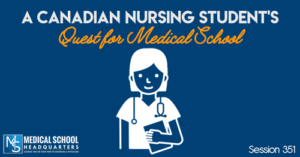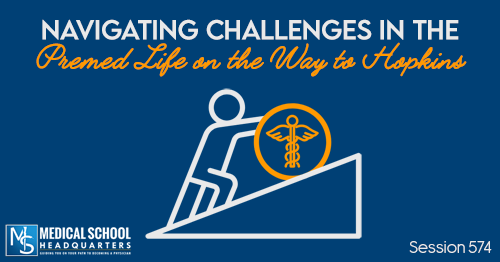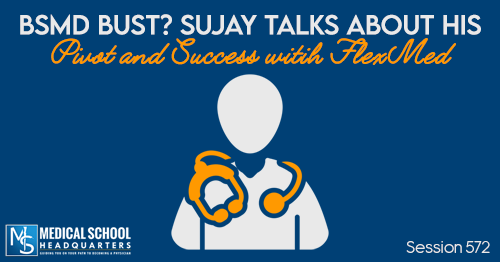Apple Podcasts | Google Podcasts

Session 351
Our guest today is proof that it’s not impossible for nontrads to get into Canadian medical school. It may be hard, but it’s not impossible. When Anita moved to Canada, she realized she was ready for a new start. She takes us through her journey from nursing, to the MCAT, to a Canadian medical school.
Please also be sure to check out all our other podcasts on the Meded Media network as we try to help you along your path.
Listen to this podcast episode with the player above, or keep reading for the highlights and takeaway points.
[01:36] Interest in Becoming a Physician
Anita moved to Canada in 2013 from Brazil when she got married. At that time, she worked as a journalist for six years, being her first degree. Her background involves working in social media, marketing, and web content for companies.
At 18, she thought medicine was only for smart kids. Having moved to Canada and feeling she was in a quarter-life crisis, Anita finally decided to pursue medicine after a few months of research, making a spreadsheet, and doing introspection.
Brazil has a different school system where you go from high school to a six-year program. They didn’t have to show any grades from high school and they only had to take one exam. The kids in high school who were going for medicine were taking all the tutoring.
Not only thinking that she wasn’t smart enough, but she also didn’t want to put in the time. So she just wanted to go straight to something. She just didn’t initially see herself as a doctor.
Anita had an emotional talk with her husband about wanting to go to medical school. At that time too, she was volunteering at a hospital. She loved the idea of delivering babies.
[Related episode: Why Do You Want to be a Doctor? You Need to Know This!]
[09:58] Going to Nursing School
During that conversation with her husband, she was told how difficult it was to get into medical school in Canada. So she had to figure it out herself.
Living in Montreal, she walked straight to McGill University’s office and asked about the process. She didn’t even know what the MCAT was at that time. Her GPA was required so she had to go back to her transcript. It was way below what was needed.
'In Brazil, people don't take grades as seriously in terms of getting jobs. People don't really care about your grades for most degrees.'Click To TweetObviously, Anita had to go back to square one. She thought about going to midwifery school or a nursing school. She learned that as a midwife, you’re on call 24/7 while as a nurse, you work in shifts.
By January 2014, she started taking prerequisites for nursing. She continued volunteering. She read books about nursing and talked with nurses in the hospital. She realized the great side of nursing in terms of spending a lot of time with patients.
'It's just as important as the doctor role. They're complementary to each other. They're of equal importance in the impact they can have.'Click To TweetShe also realized that as a nurse, her job would be important. At that time, she still thought she wasn’t going to be a doctor. So it basically took her a year and a half to get into nursing.
In nursing school, she had to re-learn how to be a student. She also found out she was good in sciences because she was led to believe she wasn’t when she was still applying for college at 18.
The whole time was a self-discovery process for her. This was more of a confirmation that she could also be good at the sciences. It wasn’t until the end of second year that she got that confidence back.
Then she began considering getting into medical school knowing she could be a competitive candidate. She also started doing research and looking into medical schools.
[Related episode: From Nursing to Premed: A Story of Lost Confidence]
[20:22] Taking the MCAT and Retaking the MCAT
Anita admitted to not respecting the MCAT as she should have. She didn’t study a lot. At that time, she attended an info session at McMaster University in Ontario. And there she found out they would only look at the CARS score. She was in her third year at this time.
'At that time, she told me, we don't look at the other sections, we only upload your CARS score.'Click To TweetSo she decided to try taking the MCAT. She also wanted to overcome the hurdle of fear of taking the MCAT. She heard of some people who gave up on medical school because they were afraid to take the MCAT. And she knew she couldn’t let this happen.
Working full-time, doing internship in public health that summer, she picked a date and place in June for a test scheduled in September. During the week, she studied for an hour in the morning. Anita used the Princeton Review CARS Textbook and signed up for their online resources. She also bought the AAMC questions.
She did questions and studied every day for a month and a half. Then she began taking timed exams. Her focus was only on CARS. She did test some biology and psychology background. So she went in and took it.
She took the MCAT twice because she wanted to do better on the other sections to open up her possibilities. The first time, she got 129 in CARS. She thought her background in writing and journalism helped.
Coming from a Humanities background, Anita thinks that even if English is your second language, but if you have a good command of the language, then maybe you would find CARS to be easier.
Moreover, Anita believes that doing a lot of questions has helped her a lot. Different courses have different strategies.
'Do timed questions. The main thing you have to find is how to finish the section in time.'Click To TweetBut ultimately, you have to figure it out on your own. Figure out how your brain works. Take notes of what works for you. Spend time figuring out your own system. Figure out how you can finish on time and increase your accuracy.
[Related episode: How Can I Score Higher on my MCAT Retake?]
[28:53] The Application Process
The first year she took the MCAT, she applied to McMaster and didn’t get anything. She figured it was going to be useful no matter what since she wanted to see the application system. She wanted to learn how to draft her application.
The second year, she applied to six schools and her spreadsheet kept growing. She looked at different schools.
'Each school had a different ratio for how many out of province people they accept.'Click To TweetMost schools have different stats for out of province. Anita filled her spreadsheet. Her second MCAT score improved but her CARS went down by one point.
She did self-study. She couldn’t apply to some schools because of the cut-offs but she applied to the ones she could apply to. So it all came down to six schools in Ontario and four out-of-province schools.
She used her previous application references and she was simply keeping things organized and had everything in on time.
Post-submission consists of the waiting game. Medical schools will just send you a receipt of your application. For most schools, you won’t hear until January.
Once you choose which schools you’re going to send your application to, you immediately have access to whatever extra each school wants from you. It’s the same process in the U.S., just a different timeline. The schools in Ontario opens on July 15 and you have until October 1.
There’s also a sketch which includes a list of your most important experiences. Basically, all the secondary stuff is there, but it’s just right away there for you.
The AACOMAS application here in the U.S. has that built-in right now. But there are only a handful of schools that utilize that. For most schools, secondary applications are still separate.
[Related episode: 4 Things You Need to Do Now to Prepare For Your Applications]
[35:13] The Interview Process and Acceptance
Anita started hearing from schools as early as December and the others in January. She wanted to take the MCAT again to increase her chances in some schools. But her husband advised that she waited and so she did. By early February, she got the email that she got an interview. She was elated.
After the interview day, she found out she got accepted after two months. It was a tough process and a stressful time for her. She had a coach to help her out for her interview.
The interview was very nice. She enjoyed the school and the people. She went through the MMI. She describes it as going somewhere you hear about for a very long time and then you finally find yourself there.
'When I entered the MMI corridor, I felt like I was in Paris. Going somewhere they hear about it for a very long time and then you're there.'Click To TweetWhen she came back home, she felt like having PTSD. From feeling very confident out of it, her confidence began to go down as the two months spread.
Finally, she got an acceptance through an email. While waiting, she did cycling classes which she found very helpful in dealing with stress and anxiety. She went to spinning class everyday. And while waiting for the shower, she checked her emails on her phone and read the great news!
[45:00] Final Words of Wisdom
Some days are great and some are terrible. Figure out what you can believe will help you achieve your goal. If you choose to believe, you’re going to have more motivation. Believe you’re a doctor and you’re doing what you need to fulfill your potential.
'Use your mind as an asset and as a help to motivate yourself. Think of your patients in the future. They're there waiting for you.'Click To TweetChoose to believe that and you’re going to get in because you can’t predict the future. Eliminate self-doubt in your head and this is going to help you motivate yourself. Your patients are waiting for you.
Not everybody has the drive to go through this process. And if you have a drive and you want to be a doctor, you owe it to your society to become a doctor. So just keep pushing!
'Self-doubt is just a distraction. You are a doctor. You're going to get there.'Click To Tweet










